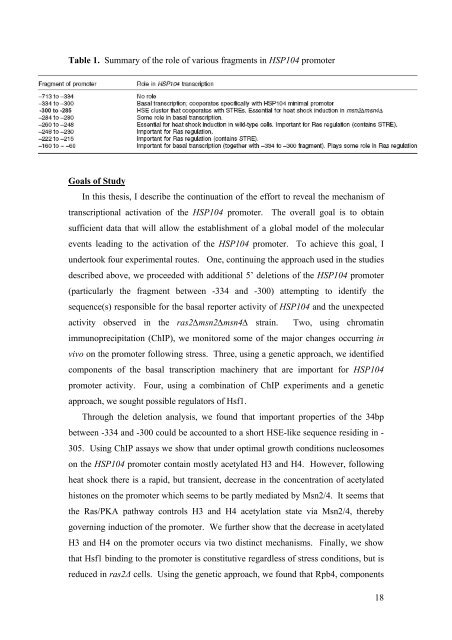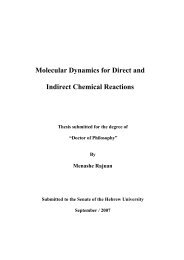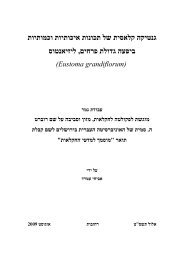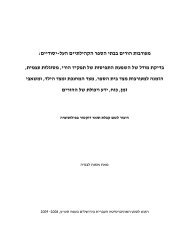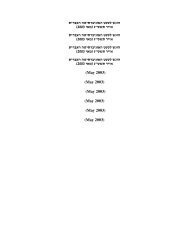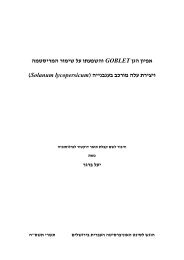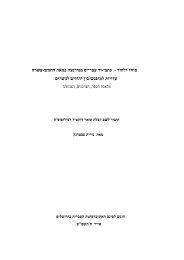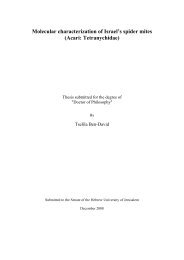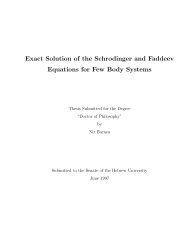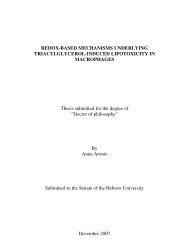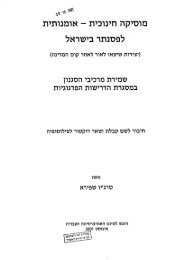Revealing the Mechanism of HSP104 Transcription Initiation in the ...
Revealing the Mechanism of HSP104 Transcription Initiation in the ...
Revealing the Mechanism of HSP104 Transcription Initiation in the ...
Create successful ePaper yourself
Turn your PDF publications into a flip-book with our unique Google optimized e-Paper software.
Table 1. Summary <strong>of</strong> <strong>the</strong> role <strong>of</strong> various fragments <strong>in</strong> <strong>HSP104</strong> promoter<br />
-300 to -285<br />
Goals <strong>of</strong> Study<br />
In this <strong>the</strong>sis, I describe <strong>the</strong> cont<strong>in</strong>uation <strong>of</strong> <strong>the</strong> effort to reveal <strong>the</strong> mechanism <strong>of</strong><br />
transcriptional activation <strong>of</strong> <strong>the</strong> <strong>HSP104</strong> promoter. The overall goal is to obta<strong>in</strong><br />
sufficient data that will allow <strong>the</strong> establishment <strong>of</strong> a global model <strong>of</strong> <strong>the</strong> molecular<br />
events lead<strong>in</strong>g to <strong>the</strong> activation <strong>of</strong> <strong>the</strong> <strong>HSP104</strong> promoter. To achieve this goal, I<br />
undertook four experimental routes. One, cont<strong>in</strong>u<strong>in</strong>g <strong>the</strong> approach used <strong>in</strong> <strong>the</strong> studies<br />
described above, we proceeded with additional 5’ deletions <strong>of</strong> <strong>the</strong> <strong>HSP104</strong> promoter<br />
(particularly <strong>the</strong> fragment between -334 and -300) attempt<strong>in</strong>g to identify <strong>the</strong><br />
sequence(s) responsible for <strong>the</strong> basal reporter activity <strong>of</strong> <strong>HSP104</strong> and <strong>the</strong> unexpected<br />
activity observed <strong>in</strong> <strong>the</strong> ras2∆msn2∆msn4∆ stra<strong>in</strong>. Two, us<strong>in</strong>g chromat<strong>in</strong><br />
immunoprecipitation (ChIP), we monitored some <strong>of</strong> <strong>the</strong> major changes occurr<strong>in</strong>g <strong>in</strong><br />
vivo on <strong>the</strong> promoter follow<strong>in</strong>g stress. Three, us<strong>in</strong>g a genetic approach, we identified<br />
components <strong>of</strong> <strong>the</strong> basal transcription mach<strong>in</strong>ery that are important for <strong>HSP104</strong><br />
promoter activity. Four, us<strong>in</strong>g a comb<strong>in</strong>ation <strong>of</strong> ChIP experiments and a genetic<br />
approach, we sought possible regulators <strong>of</strong> Hsf1.<br />
Through <strong>the</strong> deletion analysis, we found that important properties <strong>of</strong> <strong>the</strong> 34bp<br />
between -334 and -300 could be accounted to a short HSE-like sequence resid<strong>in</strong>g <strong>in</strong> -<br />
305. Us<strong>in</strong>g ChIP assays we show that under optimal growth conditions nucleosomes<br />
on <strong>the</strong> <strong>HSP104</strong> promoter conta<strong>in</strong> mostly acetylated H3 and H4. However, follow<strong>in</strong>g<br />
heat shock <strong>the</strong>re is a rapid, but transient, decrease <strong>in</strong> <strong>the</strong> concentration <strong>of</strong> acetylated<br />
histones on <strong>the</strong> promoter which seems to be partly mediated by Msn2/4. It seems that<br />
<strong>the</strong> Ras/PKA pathway controls H3 and H4 acetylation state via Msn2/4, <strong>the</strong>reby<br />
govern<strong>in</strong>g <strong>in</strong>duction <strong>of</strong> <strong>the</strong> promoter. We fur<strong>the</strong>r show that <strong>the</strong> decrease <strong>in</strong> acetylated<br />
H3 and H4 on <strong>the</strong> promoter occurs via two dist<strong>in</strong>ct mechanisms. F<strong>in</strong>ally, we show<br />
that Hsf1 b<strong>in</strong>d<strong>in</strong>g to <strong>the</strong> promoter is constitutive regardless <strong>of</strong> stress conditions, but is<br />
reduced <strong>in</strong> ras2∆ cells. Us<strong>in</strong>g <strong>the</strong> genetic approach, we found that Rpb4, components<br />
18


